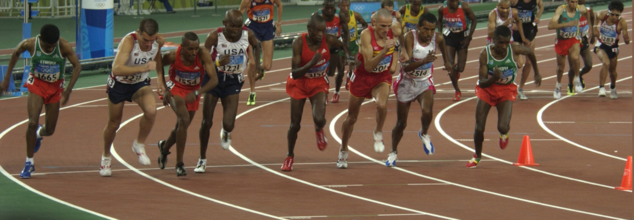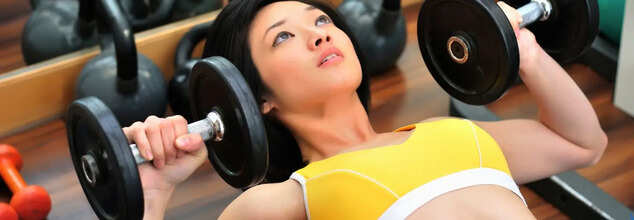- Health Conditions A-Z
- Health & Wellness
- Nutrition
- Fitness
- Health News
- Ayurveda
- Videos
- Medicine A-Z
- Parenting
- Web Stories

Image Credit: Canva
5 Olympic Sports That Burn The Most Calories- Ranked By Experts
Whether it is sprinting down a track, swimming through waves, or pedaling at breakneck speeds, different activities require different expenditures of energy. Some sports call for short, explosive bursts of power, while others test endurance over hours. The number of calories burned depends on the sport, intensity, and the athlete's unique physiology. Most Calorie-Intensive Olympic Sports : Provides a peek into the physical demands faced by athletes as well as inspiration for anyone looking to gain insight into energy use in peak performance.
The Olympics witness over 200 countries competing in more than 300 events, one can't help but wonder: which Olympic sport demands the most from the body in terms of calories burned? While every event requires exceptional physical and mental fortitude, some sports stand out as calorie-torching powerhouses. Let's break it down.
Understanding calorie burn begins with the metric of kcal/kg/hour — calories burned per kilogram of body weight per hour. To put this into perspective, an average adult weighing 185 pounds (84 kg) burns 1 kcal/kg/hour while at rest. Activities that exceed 6 kcal/kg/hour are classified as "vigorous" by the Physical Activity Guidelines for Americans. However, the caloric expenditure of Olympic sports depends on two key factors:
1. The energy surge or intensity needed in a particular moment.
2. The absolute amount of energy used throughout the period of an event.
Does Running Burn Calories?
Running, especially sprinting and marathons, takes the cake in burning calories. Sprinting is all about short bursts of high intensity, and therefore requires explosive energy. For example, a study by a physiology expert, Pietro di Prampero, reveals that in the first 0.85 seconds of the world record by Usain Bolt in the 100-meter sprint, he burnt 91.2 kcal/kg/hour.
But over all, marathons win sprints because marathons consume more energy in totality. The energy consumption per kilometer by long-distance running is approximately 1 kcal/kg. Thus, for a marathon, which runs 42 kilometers, the energy consumption will be about 42 kcal/kg.
Let's consider Eliud Kipchoge, who won the Tokyo 2020 marathon gold. At 115 pounds (52 kg), he must have burned about 2,339 calories for his 2-hour, 8-minute run, translating to 21 kcal/kg/hour.
Also Read: How Many Calories Does Walking 12,000 Steps Burn? Tips For Reaching Your Goal
Is Swimming An Silent Calorie Crusher?
Swimming is compared to running in terms of expenditure as caloric demands can vary with stroke, environment, and skill of the athlete. One study, for example was published in 2006 in the International Journal of Sports Medicine and calculated that at a swim speed of 1.6 m/s breaststroke burns 30.4 kcal/kg/hour.
Environmental factors, such as waves and cooler water temperatures, also make open-water swimming a demanding endeavor; still, strategies, such as drafting-in swimming, allows one to swim with less water resistance behind another swimmer. One reported that Michael Phelps burned more than 5,000 calories each day in the height of training, and explains his fabled 10,000-calorie diet.
- Cycling: At speed greater than 20 mph or 32 km/h, cycling is calorically costly, using 16.8 kcal/kg/hour. Competitive cycling has sustained intensity that makes it one of the most calorically expensive sports.
- Rowing: The racing speeds in rowing clock in at 15.5 kcal/kg/hour, which shows that rowing requires full-body muscular demand and cardiovascular endurance.
- Martial arts burn 10.5 kcal/kg/hour, while competitive trampolining lags slightly at 10.3 kcal/kg/hour, due to the explosive jumps and flips involved.
How Short Bursts of Energy Help Burn More Calories?
Sports that require short, intense bursts of energy — sprinting, soccer, or pole vaulting, for example — stimulate an increased post-exercise calorie burn. Known as excess post-exercise oxygen consumption (EPOC), this phenomenon means athletes burn calories at a higher rate even after the activity ends.
A study indicates that doing five 30 seconds of high intensity exercise burns the extra 200 calories a day. This fits the reason for sprinters appearing with more muscles yet lower percentages of fats compared to those who run marathon.
Sprint vs. Distance: Endurance vs. Explosiveness
Marathons and triathlons are among the longest periods of calorie burn because of extended exertion. US runner Galen Rupp, who completed a marathon in 2:06, would burn approximately 20.6 calories per minute for a total of 2,596 calories. Olympic marathon swimmers swim equivalent distances and durations, so it is likely they burn similar amounts of calories since water resistance and cooler temperatures should equate the two.
In contrast, sports like sprints and pole vault focus on explosiveness, making them metabolically intense in short bursts but less demanding in total energy.
For Olympic athletes, caloric expenditure is important both for performance and recovery. Not consuming enough calories risks losing muscles, hormonal imbalances, and weaker bones. Excessive calorie intake, on the other hand, leads to laziness. High-precision nutrition is therefore the key to attaining the most optimal energy levels and peak performance.
So, Which Olympic Sport Consumes the Highest Number of Calories?
Whereas running has taken the day regarding momentary and total calorie burn, swimming could possibly take the first spot because it engages all of the body, which demands tougher training programs. Events like marathons and triathlons require consistency in endurance while sprinting, rowing, and martial arts offer shorter intervals for high intensity calorie burn.
In the end, each Olympic sport is a demonstration of what the human body can do, taken to an extreme that is both amazing and calorie-burning.
Physical Activity Guidelines for Americans. Physical Activity Guidelines for Americans. 2018
2024 Adult Compendium of Physical Activities. Journal of Sport and Health Science. 2024
Evaluation of the Energy Expenditure in Competitive Swimming Strokes. Int J Sports Med. 2006
The energy cost of sprint running and the role of metabolic power in setting top performances. Eur J Appl Physiol. 2015

Credit: Canva
What Workout Regime Should Women With Heavy Bust Follow?
Despite being a prominent muscle group, the pectoral muscles, or pecs, are often overlooked in fitness routines, particularly by women. The growing popularity of lower body workouts has led to neglecting the chest, but fitness experts stress the importance of incorporating chest exercises for overall upper body strength and functionality.
There is a misconception that women do not need to train their pecs due to having breasts. However, the pectoralis major and minor muscles, located beneath the breast tissue, play a crucial role in maintaining good posture, enabling effective breathing, and supporting daily activities. Targeted chest workouts can significantly enhance these functions.
Pec Muscles Are Composed Of Two Main Muscles
The pecs are composed of two main muscles: the larger, fan-shaped pectoralis major and the smaller, triangular pectoralis minor, situated beneath the major muscle. Together, they assist in maintaining an upright posture and stabilising the shoulder blade and joint. Exercise physiologist Joel Seedman, Ph.D., notes that weak or overly shortened pecs can contribute to poor posture and even breathing difficulties. "If the chest muscles are shortened due to slouching at a desk, it can impair the ability to open up the diaphragm, affecting oxygen flow," he explains.
Incorporating chest workouts not only helps correct posture but also makes breathing easier by allowing the pec minor to stretch and expand the rib cage during inhalation. This is especially beneficial for those who spend long hours seated or hunched over electronic devices.
Additionally, strengthening the chest muscles can create a natural lift for the breasts. Contrary to the common belief that chest exercises can cause breast shrinkage, Seedman suggests they can actually enhance the appearance of the breasts by pushing the tissue up and forward, creating a perkier look.
Moreover, the pecs are essential for daily tasks that involve pushing, lifting, or carrying. "Nearly every upper body movement, from carrying groceries to pushing a heavy door, requires the use of pectoral muscles," says Seedman. Neglecting these muscles can lead to unnecessary strain and discomfort during such activities.
Chest Workouts Also Target Surrounding Muscles
Lastly, chest workouts not only target the pecs but also engage surrounding muscles, including the triceps, shoulders, and back. For instance, a chest press effectively strengthens the triceps while also activating the chest. A study published in the Journal of Strength & Conditioning Research highlighted that chest press variations can effectively target specific muscle groups, making them ideal for comprehensive upper body training.
For a well-rounded chest workout at home, fitness trainer Jenny Gaither, founder of the Movemeant Foundation, recommends using a set of dumbbells, a medicine ball, and a Swiss ball. Her suggested circuit includes moves like medicine ball push-ups, chest passes, single-arm chest presses, Y raises, renegade rows, and rear lateral raises. Performing each exercise in a circuit with minimal rest between sets can effectively target the chest and surrounding muscles.
Incorporating chest workouts into a regular fitness routine not only strengthens the upper body but also improves posture, breathing, and overall functionality. Whether aiming for better posture or enhanced daily performance, dedicating time to chest exercises can yield significant benefits for women of all fitness levels.

Credits: Canva
Easy Seated Yoga Poses That Help Align Your Spine
When people think of yoga they visualize someone doing vrikshasana or bhujangasana (tree pose and cobra pose). Something that looks difficult to do properly without proper practice. However, there are many poses that are easier to do and not complicated for beginners. Even with the difficult poses, it is best to do them slowly but surely, as practice makes perfect.
One such pose that is easy to do yet has many benefits is Sukhasana. It can be a transition pose between different yoga poses or something that you can practice periodically over the day. Not only will it allow your leg muscles to grow stronger but also flexible and build their endurance.
Because it's so gentle, anyone can do it, even if you're just starting your yoga journey. You'll often find Sukhasana used at the beginning or end of a yoga practice to help you settle in or wind down.
How to Do Sukhasana
This calming pose is usually held for about a minute at the start of a class. When used at the end, you might hold it for one to five minutes or even longer during meditation. Here’s how to get into Sukhasana:
- Sit on your yoga mat, a blanket, or the floor with your legs stretched out in front of you.
- Let your arms rest by your sides and gently straighten your shoulder blades.
- Slowly cross your legs at your shins, placing one leg in front of the other.
- Position each foot comfortably beneath your opposite knee in a cross-legged position.
- Place your hands on your knees with your palms facing down.
- Balance your weight evenly on your sit bones, pressing your buttocks gently into the floor or your support.
- Relax your neck and look straight ahead. Breathe deeply in for a few seconds and out for a few seconds, continuing this throughout the pose. Hold for about a minute or as instructed.
- Uncross your legs, switch which leg is in front, and repeat the steps.
If your hips feel very tight, talk to your yoga teacher about ways to modify the pose to avoid any strain. If you have hip issues, it’s better to sit on a pillow or a thick blanket instead of directly on the floor. You can also use yoga bolsters to lift your hips for more comfort
Benefits of Sukhasana
Sukhasana is a gentle and relaxing pose that helps you turn your attention inward. It also stretches your hips, makes your spine longer, and strengthens your back muscles. When you use it for meditation and rest your hands on your knees with palms up, it can symbolize being open to receiving. Placing your hands in a prayer position helps you focus during deep breaths and concentrate on your thoughts or intentions. Here are some potential benefits of this simple cross-legged pose:
Less Pain: It can help ease pain in your lower back and knees.
Better Movement: It can help loosen up your knees, hips, and ankles.
Calmness: Sukhasana can help you feel peaceful and tranquil. Focusing on your breath in this pose can bring a sense of inner peace and help you stay present.

Credits: Canva
This Fitness Test Could Predict If You’ll Make It To 100
Who though ditching flashy workout routines and trying this classic strength indicator could be the best sign of living a long, healthy life. With biohacking and wearable trackers and pricey full-body scans, it may surprise you to know that one of the easiest predictors of your future wellness isn't something digital—it's in your grasp, literally.
Grip strength, a traditional gauge of physical vigor, is only now being tapped by researchers and longevity specialists internationally. Several research studies have tied this humble test to everything from cardiovascular function and muscle strength to mental acuity and longevity. A 2015 Lancet study hit headlines when it demonstrated that weaker grip strength was a better predictor of early death than blood pressure.
So what does that mean for your health goals? It means your ability to grasp, hold, and carry may be more important than you think—especially if you plan on reaching your 90s, or even living past 100.
Grip strength measures the force exerted by the muscles in your forearm and hand. Although it may seem specialized, it's more of an indicator of your body's general musculoskeletal health. For Dr. Joshua Davidson, a strength and conditioning expert at the University of Derby, "Grip strength tells us more than how solid your handshake is. It reflects your physical activity level and general energy."
Clinical trials regularly employ a hand dynamometer—you squeeze it to test force—but you don't have to visit a lab to test your power. Davidson's suggestion is the "squeeze test": squeeze a tennis or stress ball as tight as possible for as long as possible. Keeping a squeeze of 15–30 seconds in place is an achievement to shoot for.
While a poor grip may not appear to be a big deal—perhaps you simply have a hard time opening a jar—studies reveal it can be an indicator of underlying health problems. Low grip strength correlates with frailty, sarcopenia (muscle loss), and even a higher risk of falls and fractures later in life.
Can Stronger Grip Equal Longer Life?
Decades of research have all proved that the tighter grip strength one has, the longer the lifespan. There's one especially interesting study that followed people from the 1960s into the 2000s. Patients who were in the top third of grip strength were 2.5 times more likely to live beyond the age of 100 than were those with less grip strength.
More recent evidence associates low grip strength with metabolic disorders like type 2 diabetes and insulin resistance, as well as with psychiatric disorders like depression and cognitive impairment. Why? Because muscle has a significant role in blood sugar regulation and maintenance of metabolic health. When grip strength declines, it can indicate more widespread physiological decline.
Actually, a 2019 meta-analysis in Clinical Interventions in Aging discovered grip strength was able to predict disability, cognitive impairment, and even all-cause mortality. Translation: strong hands = strong future.
Whereas social media is full of over-the-top workout fads and fix-it-in-an-hour fitness tricks, the farmer's walk, an exercise as timeless as they come, is slowly creeping back into vogue. Why? Because it's one of the best means of developing grip strength and body stability in general.
The exercise is easy: hold heavy weights in both hands and walk. That's all. But this bodyweight exercise engages your core, builds your shoulders, straightens your posture, and conditions your central nervous system to respond to physical stress.
Research has demonstrated that loaded carries such as the farmer's walk can enhance bone density, balance, and coordination—important elements in preventing injury and preserving independence in advanced age.
And the good news: you can do it at virtually any level of fitness.
How to Progress And Increase Grip Strength?
Beginner: Three sets of 30-second carries with moderate weights
Intermediate: Three sets of 45-second carries with heavier weights
Advanced: Four to five sets of 60-second carries using challenging or uneven weights such as kettlebells or sandbags
Form counts. Move at a slow gait, activate your core and glutes, breathe fully, and finish every carry feeling as if you could've done just a little more.
Tips to Improve Whole-Body Strength and Duration
Enhancing grip strength is not merely a matter of squeezing tighter. In accordance with experts such as Dr. Davidson and Dr. Leong, the strategy lies in whole-body strength development. Resistance training, particularly for the upper and lower body, enhances total muscle mass and aids in grip development.
An age-specific functional test is the "timed get-up-and-go." Stand up from a chair, walk three meters, turn, go back, and sit down again. This evaluates leg strength, balance, and agility—coinciding with what grip strength indicates about the upper body.
For daily training, use these easy exercises:
- Wrist curls (2–3 sets of 10–20 reps per arm)
- Bicep curls with kettlebells or household items
- Tennis ball holds for maximum time
These moves don’t require a fancy gym—just dedication and consistency.
If you’re aiming for healthy aging, don’t overlook your grip. Grip strength is more than a hand test—it’s a reflection of how well your body is aging. It’s accessible, low-tech, and scientifically backed. Whether you’re 30 or 70, building stronger hands through farmer’s walks and resistance training can add more quality years to your life.
In a world of health-obsessed diagnosing, perhaps it's time to return to fundamentals. In some cases, the secret to living longer lies in learning to hold on harder.
© 2024 Bennett, Coleman & Company Limited

